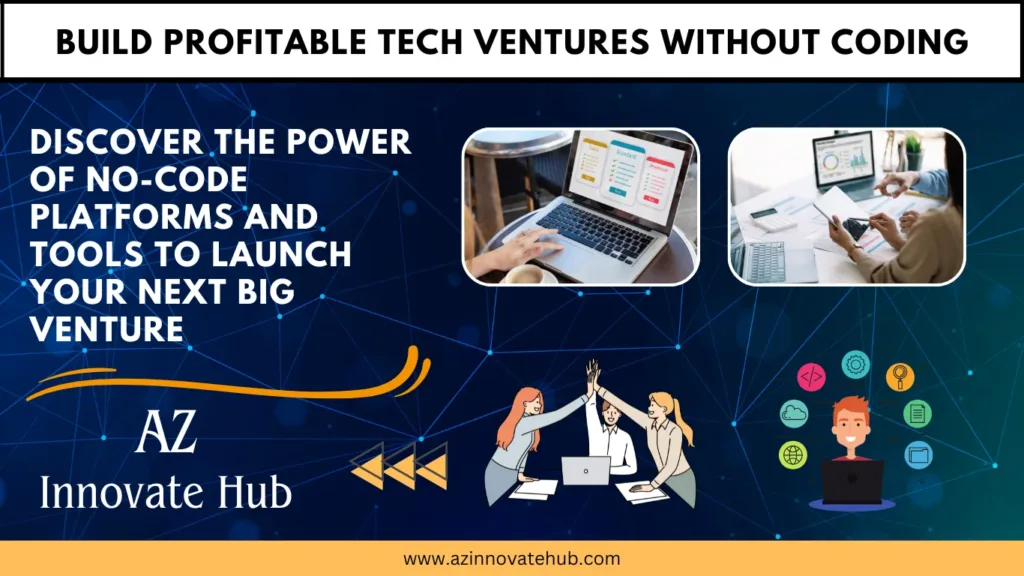
Revolutionize the Web App Development: No Coding Required
Imagine a world where anyone can launch a game-changing web app, regardless of their coding skills. Welcome to the no-code revolution!
In recent years, innovators worldwide have shattered the monopoly held by developers and Silicon Valley elites. With pioneering platforms like Bubble and WeWeb, entrepreneurs are now build web apps that tackle real-world challenges:
- Revolutionizing mental health support with AI-powered chatbots
- Transforming sustainable fashion with virtual try-on platforms
- Empowering small businesses with customized e-commerce solutions
This comprehensive guide to web app development will equip you with battle-tested strategies for identifying untapped market ripe for disruption, building compliant apps that drive real results, monetizing your app creatively for maximum ROI.
Through the real-world success stories, cutting-edge tactics, and expert insights, you’ll discover how to tap into the explosive $13.2 billion no-code industry and turn your idea into a profitable tech venture.
Get ready to join the no-code revolution and change the world!
Unlock Explosive Growth by Targeting Underserved Niches
Are you tired of competing with giants in overcrowded markets? Do you want to create a profitable business that solves real problems for a specific audience?
The secret lies in identifying under-served niches with explosive potential. These micro-audiences, such as urban beekeepers or disaster relief nonprofits, are desperate for tailored solutions.
By targeting these niches, you can:
- Avoid fierce competition: Stand out in a less crowded market and attract a loyal customer base.
- Charge premium prices: Solve urgent, specific pain points and justify higher profit margins.
So, how do you validate your niche? Here are three powerful strategies:
- Use advanced tools: Leverage platforms like SparkToro and Google Trends to analyze niche audience interests and track rising queries.
- Listen to social conversations: Scan Reddit threads, Facebook Groups, and other online communities to identify recurring complaints and pain points.
- Pre-sell your idea: Use platforms like Gumroad to sell access to a beta version of your product or service before building it.
Real-Life Success Story: AgriTrack
Meet AgriTrack, a no-code app built on Glide that helps small farmers track crop yields and connect with local buyers.
The founder validated the idea by:
- Surveying farming forums to understand the needs and pain points of small farmers
- Pre-selling subscriptions to 200 users before building the app
Today, AgriTrack earns $12,000 per month. That’s the power of targeting an underserved niche!
Ready to unlock explosive growth by targeting your own underserved niche?
Design a User-Centric App That Solves Real Problems
Now that you’ve identified your underserved niche, it’s time to design an app that truly solves their problems. This is where most entrepreneurs go wrong; they build an app that they think is cool, without validating whether it meets the need of their target audience.
The Importance of User Research
To create a successful app, you need to conduct thorough user research. This involves:
- Interviewing potential users: Reach out to people in your niche and ask them about their pain points, goals, and motivations.
- Analyzing user feedback: Use online forums, social media, and review sites to gather feedback from users who are already trying to solve the problem you’re addressing.
- Creating user personas: Develop detailed profiles of you ideal users, including their demographics, behaviors, and pain points.
Designing an Intuitive User Experience
Once you’ve gathered user feedback and created personas, it’s time to design an intuitive user experience. This involves:
- Wireframing and prototyping: Use tools like Figma, Sketch, or Adobe XD to create low-fidelity wireframes and high-fidelity prototypes.
- Usability testing: Test your prototype with real users to identify areas for improvement.
- Iterating and refining: Refine your design based on user feedback and testing results.
Case Study: Medici
Meet Medici, a telemedicine app that connects patients with doctors in minutes. The founders conducted extensive user research, including interviews with patients and doctors, to identify the key pain points in the healthcare industry.
They used this feedback to design an intuitive user experience, including a simple onboarding process, easy appointment scheduling, and secure messaging. Today, Medici is one of the leading telemedicine apps in the market.
By following these steps, you can design an app that truly solves the problems of your target audience. Remember, the key to success is to focus on user-centric design and continuous iteration.
Let’s move on to the next step, where we’ll explore how to build your app without coding.
Build Your App Without Coding Using No-Code Platforms
Now that you’ve designed a user-centric app, it’s time to bring it to life without writing a single line of code. No-code platforms have made it possible for anyone to build custom web application without extensive coding knowledge.
Choosing the Right No-Code Platform
With numerous no-code platforms available, selecting the right one can be overwhelming. Here are some factors to consider:
- Ease of use: Look for platform with intuitive interfaces and drag-and-drop functionality.
- Customization options: Choose platforms that offer flexibility in design, layout, and features.
- Scalability: Ensure the platform can hand growing traffic and user demands.
- Integrations: Consider platforms with seamless integrations with third-party services and tools.
- Cost: Evaluate the pricing plans and ensure they align with your budget.
Some popular no-code platforms for web app development include:
- Bubble: Ideal for building complex web applications with custom workflows and databases.
- Webflow: Perfect for creating responsive, design-focused web applications with a CMS.
- Adalo: Great for building mobile-friendly web application with a simple, drag-and-drop interface.
Building Web App with No-Code Platforms
Once you’ve chosen your no-code platform, it’s time to start building your app. Here’s a step-by-step guide:
- Set up your platform: Create an account, choose a template or start form scratch, and familiarize yourself with the interface.
- Design your app: Use the platform’s drag-and-drop tools to create pages, add features, and customize your app’s design.
- Add functionality: Use the platform’s built-in features or integrate third-party services to add functionality to your app.
- Test and iterate: Test your app, gather feedback, and refine your design and functionality.
- Launch and deploy: Launch your app, configure analytics and marketing tools, and deploy it to your target audience.
Case Study: FitBuddy
Meet FitBuddy, a fitness tracking app built using Bubble. The founders, with no prior coding experience, designed and launched FitBuddy in just six weeks. Today, FitBuddy has over 10,000 users and generates significant revenue through subscription-based services.
By following these steps and leveraging the power of no-code platforms, you can turn your app idea into a reality without writing a single line of code.
Launch, Market, & Monetize Your App for Success
You’ve designed and built your app; now it’s time to launch, market, and monetize it. This is where many entrepreneurs struggle, but with the right strategies, you can achieve success.
Pre-Launch Preparation
Before launching your app, ensure you:
- Test and iterate: Conduct thorough testing, gather feedback, and refine your app.
- Create a landing page: Build a landing page to showcase your app’s features, benefits, and value proposition.
- Develop a content marketing strategy: Plan and create content (blog posts, videos, social media posts) to attract and engage your target audience.
- Establish a social media presence: Create social media accounts and grow your following to build buzz around your app.
Launch Strategies
To create a successful launch, consider the following:
- Soft launch: Launch your app to a small group of users to gather feedback and test scalability.
- Influencer marketing: Partner with influencers in your niche to promote your app to their followers.
- Paid advertising: Use platforms like Google Ads, Meta Ads to reach your target audience.
- App store optimization (ASO): Optimize your app’s visibility in the app stores by using relevant keywords, descriptions, and screenshots.
Post-Launch Analysis and Optimization
After launching your app, focus on:
- Analytics and tracking: Use tools like Google Analytics or Mixpanel to track user behavior, retention, and revenue.
- User feedback and support: Collect user feedback and provide excellent support to improve user satisfaction and retention.
- A/B testing and experimentation: Continuously test and experiment with new features, designs, and marketing strategies to optimize performance.
- App updates and maintenance: Regularly update your app to fix bugs, add new features, and ensure compatibility with changing technologies.
Monetization Strategies
To generate revenue from your app, consider the following:
- In-app purchases: Offer in-app purchases for premium features, virtual goods, or subscriptions.
- Advertising: Display ads within your app, such as banner ads, interstitial ads, or video ads.
- Subscriptions: Offer subscription-based models for access to exclusive content, premium features, or priority support.
- Sponsorships and partnerships: Partner with brands or businesses to offer sponsored content, products, or services.
Case Study: Calm
Meet Calm, a meditation and relaxation app that has achieved immense success. Calm’s founders focused on creating a high-quality app with a unique value proposition, and then executed a well-planned marketing strategy. Today, Calm has over 50 million downloads and generates significant revenue through subscription-based models.
By following these steps and strategies, you can successfully launch, market, and monetize your app, achieving your business goals and creating a loyal user base.
Measure, Analyze, and Optimize Your App's Performance
To ensure your app’s long-term success, it’s crucial to continuously measure, analyze, and optimize its performance. This involves tracking key metrics, identifying areas for improvement, and making data-driven decisions.
Key Metrics to Track
Focus on the following metrics to gauge your app’s performance:
- User acquisition costs: Monitor the cost of acquiring new users, including marketing and advertising expenses.
- User retention rates: Track the percentage of users who return to your app over time.
- Average revenue per user (ARPU): Calculate the average revenue generated per user.
- Conversion rates: Measure the percentage of users who complete desired actions, such as making a purchase or signing up for a newsletter.
- Customer lifetime value (CLV): Estimate the total value of each user over their lifetime.
Analytics Tools
Utilize analytics tools to collect and analyze data:
- Google Analytics: Track website and app traffic, engagement, and conversion rates.
- Mixpanel: Analyze user behavior, retention, and funnels.
- Firebase: Monitor app performance, crashes, and user behavior.
- App Annie: Track app store rankings, reviews, and ratings.
A/B Testing and Experimentation
Continuously test and experiment with new features, designs, and marketing strategies:
- Hypothesis-driven testing: Identify areas for improvement and create hypotheses for testing.
- A/B testing tools: Use tools like Optimizely, VWO, or Google Optimize to run experiments.
- Multivariate testing: Test multiple variables simultaneously to identify complex relationships.
Case Study: Instagram
Instagram’s team continuously measures, analyzes, and optimizes the app’s performance. They use A/B testing to experiment with new features, such as the “Reels” feature, which was tested with a small group of users before being rolled out globally.
By following these steps and strategies, you can ensure your app’s long-term success by continuously measuring, analyzing, and optimizing its performance.
Maintain and Update Your App to Ensure Long-Term Success
After launching your app, it’s essential to maintain and update it regularly to ensure long-term success. This involves fixing bugs, adding new features, and adapting to changing user needs and market trends.
Importance of Maintenance and Updates
Regular maintenance and updates are crucial for:
- Bug fixing: Identify and fix bugs to ensure a smooth user experience.
- Security patches: Apply security patches to protect user data and prevent hacking.
- New feature additions: Add new features to stay competitive and meet evolving user needs.
- Performance optimization: Optimize app performance to improve speed, battery life, and overall user experience.
- Platform updates: Adapt to changing platform requirements, such as new iOS or Android versions.
Maintenance and Update Strategies
To maintain and update your app effectively:
- Prioritize bug fixing: Fix critical bugs immediately to prevent user frustration.
- Use analytics tools: Monitor user behavior and app performance to identify areas for improvement.
- Conduct user surveys: Gather feedback from users to inform new feature additions and updates.
- Implement a continuous integration/continuous deployment (CI/CD) pipeline: Automate testing, building, and deployment to streamline updates.
- Collaborate with your development team: Work closely with your development team to ensure smooth maintenance and updates.
Case Study: Spotify
Spotify’s team prioritizes maintenance and updates to ensure a seamless user experience. They use analytics tools to identify areas for improvement and conduct user surveys to inform new feature additions. Spotify’s CI/CD pipeline enables rapid deployment of updates, ensuring the app stays competitive and meets evolving user needs.
By following these strategies, you can maintain and update your app effectively, ensuring long-term success and a loyal user base.
Scale Your App to Reach New Heights
Now that you’ve launched, maintained, and updated your app, it’s time to scale it to reach new heights. Scaling involves growing your user base, increasing revenue, and expanding your app’s reach.
Scaling Strategies
To scale your app effectively:
- Invest in user acquisition: Allocate budget to targeted marketing campaigns to attract new users.
- Optimize your app’s onboarding process: Streamline the onboarding process to reduce friction and increase user retention.
- Enhance your app’s virality: Implement features that encourage users to share your app with others.
- Explore new markets and platforms: Expand your app’s reach by launching on new platforms, such as wearables or TVs.
- Build strategic partnerships: Collaborate with other businesses or organizations to expand your app’s reach.
Scaling Tools and Technologies
Utilize the following tools and technologies to support your scaling efforts:
- Cloud infrastructure: Leverage cloud services like AWS or Google Cloud to handle increased traffic and user demand.
- Containerization: Use containerization tools like Docker to streamline deployment and scaling.
- Automation tools: Implement automation tools like Zapier or IFTTT to streamline workflows and reduce manual labor.
- Data analytics platforms: Use data analytics platforms like Mixpanel or Amplitude to track user behavior and optimize your scaling strategy.
Case Study: Pokémon Go
Pokémon Go’s developers, Niantic, successfully scaled their app by investing in user acquisition, optimizing the onboarding process, and enhancing the app’s virality. They also explored new markets and platforms, such as the Apple Watch, to expand their reach.
By following these strategies and leveraging the right tools and technologies, you can scale your app to reach new heights and achieve long-term success.
Monitor and Adjust Your Strategy for Ongoing Success
To ensure ongoing success, it’s essential to continuously monitor your app’s performance and adjust your strategy as needed.
Key Performance Indicators (KPIs) to Track
Focus on the following KPIs to measure your app’s performance:
- User acquisition and retention rates: Track the number of new users and retained users over time.
- Revenue and monetization metrics: Monitor revenue, average revenue per user (ARPU), and conversion rates.
- User engagement and satisfaction: Measure user engagement through metrics like time spent in-app, sessions per user, and satisfaction ratings.
- App store optimization (ASO) metrics: Track app store rankings, reviews, and ratings.
Adjusting Your Strategy
Based on your KPIs, adjust your strategy by:
- Refining your target audience: Adjust your marketing efforts to better target your ideal user.
- Optimizing your user experience: Improve your app’s usability, performance, and overall user experience.
- Enhancing your monetization strategy: Experiment with new revenue streams, such as in-app purchases or advertising.
- Investing in user retention: Develop strategies to retain users, such as loyalty programs or regular updates.
Tools for Ongoing Monitoring and Optimization
Utilize the following tools to support your ongoing monitoring and optimization efforts:
- Analytics platforms: Leverage platforms like Google Analytics, Mixpanel, or Amplitude to track KPIs.
- A/B testing tools: Use tools like Optimizely, VWO, or Google Optimize to experiment with new features and optimizations.
- User feedback and survey tools: Collect user feedback through tools like SurveyMonkey, UserVoice, or Medallia.
Stay Ahead of the Competition with Continuous Innovation
To maintain a competitive edge, it’s essential to continuously innovate and improve your app. This involves staying up-to-date with the latest trends, technologies, and user preferences.
Staying Ahead of the Curve
To stay ahead of the competition:
- Attend industry conferences and events: Stay informed about the latest trends and technologies.
- Participate in online communities: Engage with other developers, entrepreneurs, and industry experts.
- Conduct market research: Analyze your competitors, identify gaps in the market, and gather user feedback.
- Experiment with new technologies: Explore emerging technologies like AI, AR, and blockchain.
Innovating and Improving Your App
To continuously innovate and improve your app:
- Gather user feedback: Collect feedback through surveys, reviews, and social media.
- Analyze user behavior: Use analytics tools to understand user behavior and identify areas for improvement.
- Conduct A/B testing: Experiment with new features, designs, and functionalities.
- Collaborate with your team: Work closely with your development team to prioritize and implement new features.
Plan for the Future and Scale Your App Business
Congratulations! You’ve successfully launched and grown your app. Now it’s time to plan for the future and scale your app business.
Planning for the Future
To plan for the future:
- Set long-term goals: Define your vision, mission, and objectives for the next 3-5 years.
- Conduct market research: Analyze industry trends, competitor activity, and user behavior.
- Identify new opportunities: Explore new markets, platforms, and revenue streams.
- Develop a roadmap: Create a detailed plan outlining key milestones, timelines, and resources required.
Scaling Your App Business
To scale your app business:
- Build a strong team: Hire experienced professionals to help you manage growth.
- Establish partnerships: Collaborate with other businesses, organizations, or influencers to expand your reach.
- Invest in infrastructure: Upgrade your technology, infrastructure, and processes to support growth.
- Focus on user retention: Develop strategies to retain users, reduce churn, and increase lifetime value.
This concludes our guide to creating a successful app. Remember to stay focused, adapt to change, and continuously innovate to drive growth and success.



